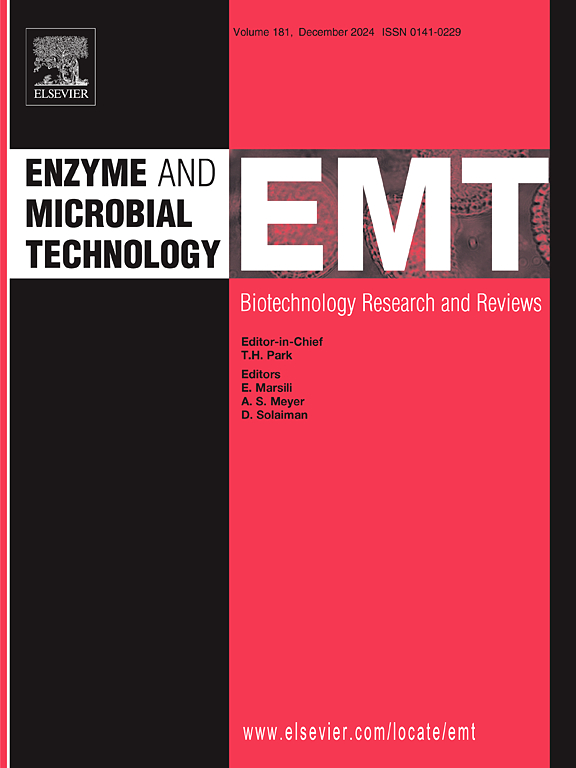Preparation, and enzymatic activity analysis of an engineered capping enzyme
IF 3.7
3区 生物学
Q2 BIOTECHNOLOGY & APPLIED MICROBIOLOGY
引用次数: 0
Abstract
The Vaccinia capping enzyme (VCE) and the 2’-O-methyltransferase (VP39) are proteins encoded by the vaccinia virus genome, used for capping viral mRNA to form m7GpppN2Me mRNA (Cap1 mRNA). This capping structure is essential for protecting mRNA from degradation, facilitating pre-mRNA splicing and nuclear export, and enabling translation initiation by the eukaryotic initiation factor (eIF4E). Moreover, it helps the virus circumvent innate immune responses, thereby facilitating replication using host cell mechanisms. Currently, the enzymatic capping process employs VCE and VP39 in concert with pre-mRNA to synthesize Cap1 mRNA directly. This study introduces an engineered fusion capping enzyme , created by linking VCE and VP39 via a flexible (GGGGS)3 linker(D1R-D12L-GS linker-VP39, DDGSV). The aim is to enhance the capping reaction while reducing raw material costs, process complexity, and impurities. The tertiary structure of DDGSV, predicted using AlphaFold2, aligns well with published structures of VCE and VP39, demonstrating no steric hindrance at the enzymatic active sites resulting from the fusion configuration. The expression vector pTolo-EX2-DDGSV was constructed and expressed in Escherichia coli BL21(DE3). The mRNA of the prepared capping enzymes exhibited good integrity on an agarose gel. The capping efficiency of the engineered enzyme DDGSV reached 80.19 % after 2 h of the capping reaction, matching the performance of commercial capping enzymes. Furthermore, the potential of RNA dot blotting for rapid detection of mRNA capping efficiency was explored; however, quantitative methods are also needed. Additionally, GFP mRNA prepared using DDGSV demonstrated high expression levels in HEK 293 T cells. These results indicate that the engineered enzyme can effectively cap Cap1 mRNA, providing a novel approach for mRNA vaccine development.
一种工程盖盖酶的制备及酶活性分析
牛痘病毒的capping酶(VCE)和2 ' - o -甲基转移酶(VP39)是由牛痘病毒基因组编码的蛋白,用于capping病毒mRNA形成m7GpppN2Me mRNA (Cap1 mRNA)。这种帽盖结构对于保护mRNA免受降解,促进mRNA前剪接和核输出以及真核起始因子(eIF4E)启动翻译至关重要。此外,它帮助病毒绕过先天免疫反应,从而促进利用宿主细胞机制进行复制。目前,酶capping过程利用VCE和VP39与pre-mRNA协同直接合成Cap1 mRNA。本研究介绍了一种工程融合capping酶,该酶通过一个柔性(GGGGS)3连接体(D1R-D12L-GS连接体-VP39, DDGSV)将VCE和VP39连接起来。目的是提高封盖反应,同时降低原材料成本,工艺复杂性和杂质。利用AlphaFold2预测的DDGSV的三级结构与已发表的VCE和VP39的结构非常吻合,在酶活性位点上没有由于融合结构而产生的空间位阻。构建表达载体pTolo-EX2-DDGSV,并在大肠杆菌BL21(DE3)中表达。制备的盖帽酶mRNA在琼脂糖凝胶上表现出良好的完整性。经过2 h的旋盖反应,工程酶DDGSV的旋盖效率达到80.19 %,与商品旋盖酶的性能相当。此外,我们还探讨了RNA点印迹法快速检测mRNA盖帽效率的潜力;然而,定量方法也是必要的。此外,使用DDGSV制备的GFP mRNA在HEK 293 T细胞中表现出高表达水平。这些结果表明,该工程酶可以有效地封盖Cap1 mRNA,为mRNA疫苗的开发提供了一种新的途径。
本文章由计算机程序翻译,如有差异,请以英文原文为准。
求助全文
约1分钟内获得全文
求助全文
来源期刊

Enzyme and Microbial Technology
生物-生物工程与应用微生物
CiteScore
7.60
自引率
5.90%
发文量
142
审稿时长
38 days
期刊介绍:
Enzyme and Microbial Technology is an international, peer-reviewed journal publishing original research and reviews, of biotechnological significance and novelty, on basic and applied aspects of the science and technology of processes involving the use of enzymes, micro-organisms, animal cells and plant cells.
We especially encourage submissions on:
Biocatalysis and the use of Directed Evolution in Synthetic Biology and Biotechnology
Biotechnological Production of New Bioactive Molecules, Biomaterials, Biopharmaceuticals, and Biofuels
New Imaging Techniques and Biosensors, especially as applicable to Healthcare and Systems Biology
New Biotechnological Approaches in Genomics, Proteomics and Metabolomics
Metabolic Engineering, Biomolecular Engineering and Nanobiotechnology
Manuscripts which report isolation, purification, immobilization or utilization of organisms or enzymes which are already well-described in the literature are not suitable for publication in EMT, unless their primary purpose is to report significant new findings or approaches which are of broad biotechnological importance. Similarly, manuscripts which report optimization studies on well-established processes are inappropriate. EMT does not accept papers dealing with mathematical modeling unless they report significant, new experimental data.
 求助内容:
求助内容: 应助结果提醒方式:
应助结果提醒方式:


